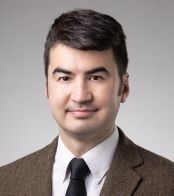Lead Guest Editor, Michael Pittman: PhD, MSc, School of Life Sciences, The Chinese University of Hong Kong, Shatin, Hong Kong SAR, China
 Dr Michael Pittman is an integrative, multidisciplinary palaeobiologist at The Chinese University of Hong Kong. He earned a BSc in Geology, MSc in Geoscience and PhD in Palaeobiology from UCL. His palaeobiology research covers anatomy, systematics, biomechanics, ecology and macroevolution, particularly of dinosaurs, the dinosaur-to-bird transition and vertebrate flight origins. He studies exceptionally preserved fossils using multiple methods, including laser-stimulated fluorescence. In addition to the journal’s Editorial Board and guest editing its collection ‘Paleoecology of extinct species’, he edited the special volume Pennaraptoran Theropod Dinosaurs: Past Progress and New Frontiers and organizes the International Pennaraptoran Dinosaur Symposium that includes outcomes here.
Dr Michael Pittman is an integrative, multidisciplinary palaeobiologist at The Chinese University of Hong Kong. He earned a BSc in Geology, MSc in Geoscience and PhD in Palaeobiology from UCL. His palaeobiology research covers anatomy, systematics, biomechanics, ecology and macroevolution, particularly of dinosaurs, the dinosaur-to-bird transition and vertebrate flight origins. He studies exceptionally preserved fossils using multiple methods, including laser-stimulated fluorescence. In addition to the journal’s Editorial Board and guest editing its collection ‘Paleoecology of extinct species’, he edited the special volume Pennaraptoran Theropod Dinosaurs: Past Progress and New Frontiers and organizes the International Pennaraptoran Dinosaur Symposium that includes outcomes here.
Thomas Alexander Dececchi: PhD, Dakota State University, USA
 Dr Thomas Alexander Dececchi received his PhD from McGill University with a focus on vertebrate paleontology and more specifically the dinosaur to bird transition. His work looks at this transition, as well as the origin of flight, from a holistic perspective incorporating morphological, physiological, and behavioral information to more accurately reconstruct the paleoecology of paravian dinosaurs. He is currently an Assistant Professor in Biology at Dakota State University where his students and he are looking at new methods and perspectives to address currently unresolved aspects of this and other major vertebrate locomotory transitions.
Dr Thomas Alexander Dececchi received his PhD from McGill University with a focus on vertebrate paleontology and more specifically the dinosaur to bird transition. His work looks at this transition, as well as the origin of flight, from a holistic perspective incorporating morphological, physiological, and behavioral information to more accurately reconstruct the paleoecology of paravian dinosaurs. He is currently an Assistant Professor in Biology at Dakota State University where his students and he are looking at new methods and perspectives to address currently unresolved aspects of this and other major vertebrate locomotory transitions.
Norberto Pedro Giannini: PhD, Unidad Ejecutora Lillo, CONICET – Fundación Miguel Lillo, Argentina
 Dr Norberto Pedro Giannini is an Evolutionary Biologist focusing on bats, marsupials, and other mammals, some birds and plants, as well as the ecology of plant-animal interactions from an evolutionary perspective. He works in NW Argentina, Universidad Nacional de Tucumán and CONICET, associated with the Department of Mammalogy of the American Museum of Natural History, New York. Broadly, his research interests include major transitions in evolution, chiefly evolution of flight in mammals, integrating multiple sources of evidence such as fossils, aerodynamics, paleobiology, development, and phylogenetics.
Dr Norberto Pedro Giannini is an Evolutionary Biologist focusing on bats, marsupials, and other mammals, some birds and plants, as well as the ecology of plant-animal interactions from an evolutionary perspective. He works in NW Argentina, Universidad Nacional de Tucumán and CONICET, associated with the Department of Mammalogy of the American Museum of Natural History, New York. Broadly, his research interests include major transitions in evolution, chiefly evolution of flight in mammals, integrating multiple sources of evidence such as fossils, aerodynamics, paleobiology, development, and phylogenetics.
Michael B. Habib: PhD, MS, UCLA Cardiac Arrhythmia Center, USA
 Dr Michael Habib is an Adjunct Associate Professor of Medicine at the University of California Los Angeles and a Research Associate in the Natural History Museum of Los Angeles County. Dr Habib explores the relationships between animal structure and motion, particularly in the field of aeroemechanics, using a combination of comparative anatomy, art, and engineering. His work on animal launch provided the first robust explanation of giant size in pterosaurs and led to a fundamental reassessment of the mechanical limits of flying animals. Dr Habib has authored over 40 peer reviewed papers, with most of this body of work related to the origins and evolution of animal flight.
Dr Michael Habib is an Adjunct Associate Professor of Medicine at the University of California Los Angeles and a Research Associate in the Natural History Museum of Los Angeles County. Dr Habib explores the relationships between animal structure and motion, particularly in the field of aeroemechanics, using a combination of comparative anatomy, art, and engineering. His work on animal launch provided the first robust explanation of giant size in pterosaurs and led to a fundamental reassessment of the mechanical limits of flying animals. Dr Habib has authored over 40 peer reviewed papers, with most of this body of work related to the origins and evolution of animal flight.
BMC Ecology and Evolution invites submissions to our Collection on Evolution of vertebrate flight. This Collection invites researchers to contribute their work on the diverse aspects of flight evolution in vertebrates. It also seeks to showcase research on anatomical adaptations, evolutionary transitions, ecological implications, and genetic underpinnings of flight in vertebrates. By advancing our understanding of vertebrate flight, this Collection aims to provide valuable insights into the mechanisms of evolution and the ecological interactions of flying organisms.